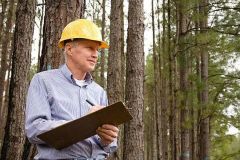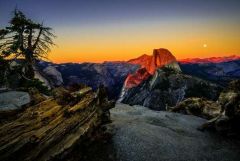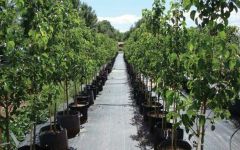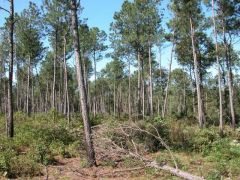![]()
![]()
![]()
Use LEFT and RIGHT arrow keys to navigate between flashcards;
Use UP and DOWN arrow keys to flip the card;
H to show hint;
A reads text to speech;
22 Cards in this Set
- Front
- Back
- 3rd side (hint)
|
A person educated and trained as a forest professional is called a _____________. |
Forester |

|
|
|
The application of business methods and technical forestry principals to the operation of a forest to obtain a high level of productivity is known as ________________ _______________. |
Intensive Forestry |
|
|
|
Long term planning to insure that the growth of timber on a particular piece if land will keep up with the harvest is the _______________ __________ management philosophy. |
Sustained Yeild |
|
|
|
A federally owned piece of land managed by the federal government for the purpose of preserving scenery, flora, and fauna for public enjoyment for eternity is a _________________ ________. |
National Park |

|
|
|
Conversely, federally owned land managed by the government for the purpose of multiple use and sustained yield of timber is a _______________ ___________. |
National Forest |
|
|
|
Privately owned land managed by company employees or the land owner for the purpose of bearing merchantable timber that is either currently or prospectively accessible is called ________________ ______________, or a ___________________ _______________. |
Industrial Forest or a Commercial Forest |
|
|
|
After trees are cut from a piece of land, it is in the best interest of the landowner to return the land to the forest (and legally required). When existing trees are allowed to disperse their seeds, or when small trees sprout from the stumps of cut trees, it is called _____________ ___________________. |
Natural Regeneration |
|
|
|
When the landowner plants seeds or small trees in the land, it is called ______________ ___________________. |
Artificial Regeneration |
|
|
|
An area set aside for young trees to be planted in a forest is a ____________. Those young trees are called ______________ __________ |
Nursery and Planting Stock |
|
|
|
A _________________ is a seedling that has lived in more than one place before it is planted out in the forest. |
Transplant |
|
|
|
Seedling that have soil removed before planting and are planted directly into the forest soil are _______ __________ plantings. |
Bear Rooted |
|
|
|
Seedlings grown in a small tube and transported to the forest for planting intact are called _____________ ___________ seedlings |
Container Grown |

|
|
|
When the trees are finally planted in the forest, they are often set between existing trees or brush, a process called _____________________. |
Interplanting |
|
|
|
A natural forest uninfluenced by human activity is a _________ forest. |
Virgin |
|
|
|
Managing a forest properly requires the forester to have objective information about the spieces and ages of trees in an area. If the trees are of varying ages, it is an _________ ________ stand, whereas an _________ ________ stand has trees that are generally no more than 10 to 20 years different in age. |
Uneven Aged and Even Aged |
|
|
|
The predominant species within a stand is the _______________ ____________, the one around which management activities are based. |
Principal Species |
|
|
|
A forester can determine the amount of lumber contained in a tree by measuring the dbh and height and using a _____________ ____________. |
Volume Table |
|
|
|
A forest full of stunted trees and/or shrubs that are not merchantable is called __________; a small but well growing tree that us one size away from being merchantable is an __________________ tree. |
Scrub and Adolescent |
|
|
|
______ ________________ ___________ refers to cutting trees that are not yet merchantable size in order to allow the remaining trees (often better formed trees) room to grow faster. |
Pre Commercial Thinning |

|
|
|
Once a forester gets precise information on how fast the trees in a forest are growing, and how healthy they are, the location can be catergorized into a _______ __________, which are denoted by the roman numerals I, II, III, and IV. |
Site Class |
|
|
|
It is often helpful to the forester to put this information onto a map to get an overview of the entire property. This map is called a ________ ______. |
Site Map |
|
|
|
By knowing site classes of land, and using a volume table as well as other tools, the __________ __________ or piece that a stand of timber could be sold for as it stands, can be determined. |
Market Value |
|

